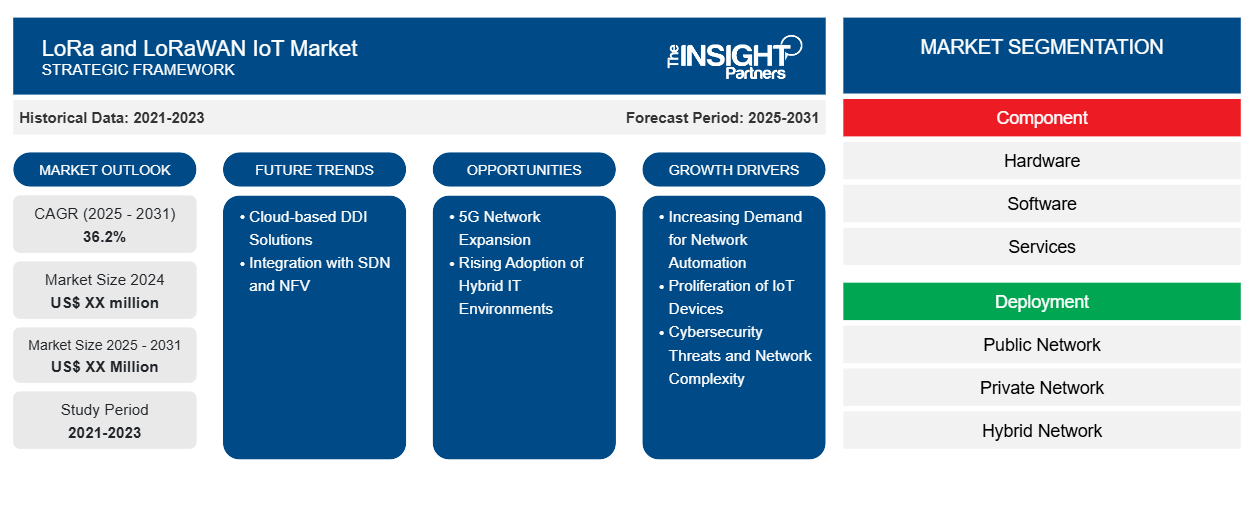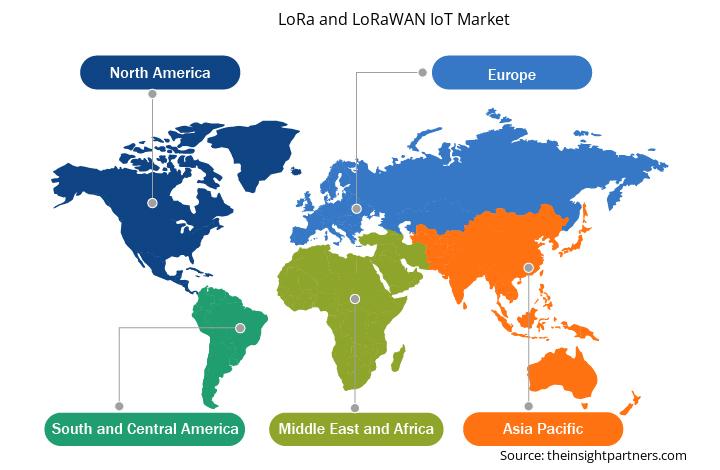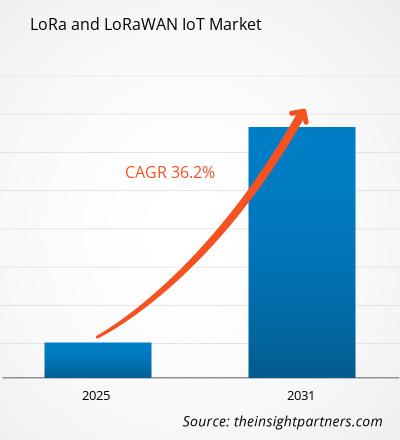Si prevede che il mercato IoT LoRa e LoRaWAN registrerà un CAGR del 36,2% dal 2025 al 2031, con una dimensione di mercato in espansione da XX milioni di dollari nel 2024 a XX milioni di dollari entro il 2031.
Il report è segmentato per Componente (Hardware, Software, Servizi); Distribuzione (Rete pubblica, Rete privata, Rete ibrida); Dimensioni dell'organizzazione (Grandi imprese, PMI); Utenti finali (Produzione, Trasporti e logistica, Energia e servizi di pubblica utilità, Governo e sicurezza pubblica, Sanità, Vendita al dettaglio, altri). L'analisi globale è ulteriormente suddivisa a livello regionale e nei principali paesi. Il report offre il valore in USD per l'analisi e i segmenti di cui sopra
Scopo del rapporto
Il report LoRa and LoRaWAN IoT Market di The Insight Partners mira a descrivere il panorama attuale e la crescita futura, i principali fattori trainanti, le sfide e le opportunità. Ciò fornirà spunti a vari stakeholder aziendali, come:
- Fornitori/produttori di tecnologia: per comprendere le dinamiche di mercato in evoluzione e conoscere le potenziali opportunità di crescita, consentendo loro di prendere decisioni strategiche informate.
- Investitori: condurre un'analisi completa delle tendenze in merito al tasso di crescita del mercato, alle proiezioni finanziarie del mercato e alle opportunità esistenti lungo la catena del valore.
- Enti di regolamentazione: regolamentano le politiche e le attività di controllo sul mercato allo scopo di ridurre al minimo gli abusi, preservare la fiducia degli investitori e sostenere l'integrità e la stabilità del mercato.
Segmentazione del mercato IoT LoRa e LoRaWAN
Componente
- Hardware
- Software
- Servizi
Distribuzione
- Rete pubblica
- Rete privata
- Rete ibrida
Dimensione dell'organizzazione
- Grandi Imprese
- PMI
Utenti finali
- Produzione
- Trasporti e logistica
- Energia e servizi di pubblica utilità
- Governo e sicurezza pubblica
- Assistenza sanitaria
- Vedere al dettaglio
Personalizza questo report in base alle tue esigenze
Riceverai la personalizzazione gratuita di qualsiasi report, comprese parti di questo report, o analisi a livello nazionale, pacchetto dati Excel, oltre a usufruire di grandi offerte e sconti per start-up e università
Mercato IoT LoRa e LoRaWAN: approfondimenti strategici

- Scopri le principali tendenze di mercato in questo rapporto.Questo campione GRATUITO includerà analisi di dati che spaziano dalle tendenze di mercato alle stime e alle previsioni.
Driver di crescita del mercato IoT LoRa e LoRaWAN
- Domanda crescente di automazione di rete: con l'espansione delle aziende e la crescita della complessità delle infrastrutture IT, aumenta la domanda di soluzioni di automazione di rete. Le soluzioni DDI (DNS, DHCP e gestione degli indirizzi IP) automatizzano le operazioni di rete, migliorando l'efficienza operativa, riducendo gli errori manuali e consentendo la scalabilità. Questa crescente domanda di automazione nella gestione di ambienti di indirizzi IP dinamici guida direttamente la crescita del mercato DDI.
- Proliferazione di dispositivi IoT: il rapido aumento dei dispositivi connessi, alimentato dall'Internet of Things (IoT), ha notevolmente ampliato la necessità di una gestione efficiente degli indirizzi IP. Le soluzioni DDI aiutano a gestire un vasto numero di indirizzi IP, fornendo dati in tempo reale e riducendo al minimo i tempi di inattività automatizzando l'allocazione IP e garantendo la scalabilità della rete, guidando la crescita del mercato DDI.
- . Minacce alla sicurezza informatica e complessità di rete: con l'aumento delle minacce alla sicurezza informatica e reti più complesse, le aziende richiedono soluzioni di gestione DNS, DHCP e indirizzi IP robuste per un migliore controllo, visibilità e sicurezza. Le soluzioni DDI migliorano la resilienza di rete, garantendo protezione contro attacchi DDoS, spoofing DNS e altre vulnerabilità, che rappresentano un fattore chiave per il mercato.
Tendenze future del mercato IoT LoRa e LoRaWAN
- Soluzioni DDI basate su cloud: l'adozione del cloud sta crescendo rapidamente in tutti i settori, portando a una crescente preferenza per le soluzioni DDI basate su cloud. Queste soluzioni offrono flessibilità, economicità e scalabilità, consentendo alle aziende di gestire l'infrastruttura di rete in più ambienti. Il passaggio ai servizi basati su cloud è una tendenza significativa che alimenta l'espansione del mercato DDI.
- Integrazione con SDN e NFV: l'integrazione delle soluzioni DDI con Software-Defined Networking (SDN) e Network Function Virtualization (NFV) sta trasformando il modo in cui vengono gestite le reti. Questa tendenza consente il provisioning dinamico e automatizzato dei servizi di rete, creando infrastrutture più agili, flessibili e sicure, accelerando ulteriormente l'adozione delle tecnologie DDI.
Opportunità di mercato IoT LoRa e LoRaWAN
- Espansione della rete 5G: il lancio delle reti 5G presenta opportunità significative per le soluzioni DDI. Il 5G promette di aumentare notevolmente il numero di dispositivi e utenti connessi, richiedendo una gestione degli indirizzi IP più sofisticata. I fornitori DDI possono sfruttare questa crescente necessità di una migliore allocazione e gestione degli indirizzi, incrementando le opportunità di mercato.
- Crescente adozione di ambienti IT ibridi: man mano che le organizzazioni si spostano verso ambienti IT ibridi che combinano infrastrutture on-premise e cloud, necessitano di soluzioni DDI efficienti per gestire senza problemi diversi ambienti di rete. Questa crescente adozione di ambienti ibridi offre ai fornitori DDI l'opportunità di fornire soluzioni complete per gestire efficacemente queste reti complesse.
Approfondimenti regionali sul mercato IoT LoRa e LoRaWAN
Le tendenze regionali e i fattori che influenzano il mercato IoT LoRa e LoRaWAN durante il periodo di previsione sono stati ampiamente spiegati dagli analisti di Insight Partners. Questa sezione discute anche i segmenti e la geografia del mercato IoT LoRa e LoRaWAN in Nord America, Europa, Asia Pacifico, Medio Oriente e Africa e America meridionale e centrale.

- Ottieni i dati specifici regionali per il mercato IoT LoRa e LoRaWAN
Ambito del rapporto di mercato IoT LoRa e LoRaWAN
| Attributo del report | Dettagli |
|---|---|
| Dimensioni del mercato nel 2024 | XX milioni di dollari USA |
| Dimensioni del mercato entro il 2031 | XX milioni di dollari USA |
| CAGR globale (2025 - 2031) | 36,2% |
| Dati storici | 2021-2023 |
| Periodo di previsione | 2025-2031 |
| Segmenti coperti | Per componente
|
| Regioni e Paesi coperti | America del Nord
|
| Leader di mercato e profili aziendali chiave |
|
Densità dei player del mercato IoT LoRa e LoRaWAN: comprendere il suo impatto sulle dinamiche aziendali
Il mercato IoT LoRa e LoRaWAN sta crescendo rapidamente, spinto dalla crescente domanda degli utenti finali dovuta a fattori quali l'evoluzione delle preferenze dei consumatori, i progressi tecnologici e una maggiore consapevolezza dei vantaggi del prodotto. Con l'aumento della domanda, le aziende stanno ampliando le loro offerte, innovando per soddisfare le esigenze dei consumatori e capitalizzando sulle tendenze emergenti, il che alimenta ulteriormente la crescita del mercato.
La densità degli operatori di mercato si riferisce alla distribuzione di aziende o società che operano in un particolare mercato o settore. Indica quanti concorrenti (operatori di mercato) sono presenti in un dato spazio di mercato in relazione alle sue dimensioni o al valore di mercato totale.
Le principali aziende che operano nel mercato IoT LoRa e LoRaWAN sono:
- Gruppo Bosch
- Cisco
- Arancione SA
- Società Comcast
- Semtech
- Società NEC
Disclaimer : le aziende elencate sopra non sono classificate secondo un ordine particolare.

- Ottieni una panoramica dei principali attori del mercato IoT LoRa e LoRaWAN
Punti chiave di vendita
- Copertura completa: il rapporto copre in modo completo l'analisi di prodotti, servizi, tipologie e utenti finali del mercato IoT LoRa e LoRaWAN, fornendo una panoramica olistica.
- Analisi degli esperti: il rapporto è compilato sulla base della conoscenza approfondita di esperti e analisti del settore.
- Informazioni aggiornate: il rapporto garantisce la pertinenza aziendale grazie alla copertura di informazioni recenti e tendenze nei dati.
- Opzioni di personalizzazione: questo report può essere personalizzato per soddisfare le esigenze specifiche del cliente e adattarsi in modo appropriato alle strategie aziendali.
Il rapporto di ricerca sul mercato IoT LoRa e LoRaWAN può, quindi, aiutare a guidare il percorso di decodifica e comprensione dello scenario del settore e delle prospettive di crescita. Sebbene possano esserci alcune preoccupazioni valide, i vantaggi complessivi di questo rapporto tendono a superare gli svantaggi.
- Analisi storica (2 anni), anno base, previsione (7 anni) con CAGR
- Analisi PEST e SWOT
- Valore/volume delle dimensioni del mercato - Globale, Regionale, Nazionale
- Industria e panorama competitivo
- Set di dati Excel
Report recenti
Testimonianze
Motivo dell'acquisto
- Processo decisionale informato
- Comprensione delle dinamiche di mercato
- Analisi competitiva
- Analisi dei clienti
- Previsioni di mercato
- Mitigazione del rischio
- Pianificazione strategica
- Giustificazione degli investimenti
- Identificazione dei mercati emergenti
- Miglioramento delle strategie di marketing
- Aumento dell'efficienza operativa
- Allineamento alle tendenze normative






















 Ottieni un campione gratuito per - Mercato IoT LoRa e LoRaWAN
Ottieni un campione gratuito per - Mercato IoT LoRa e LoRaWAN